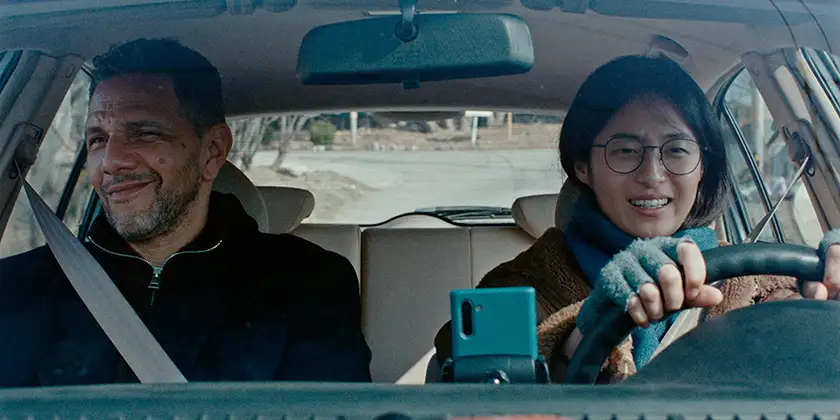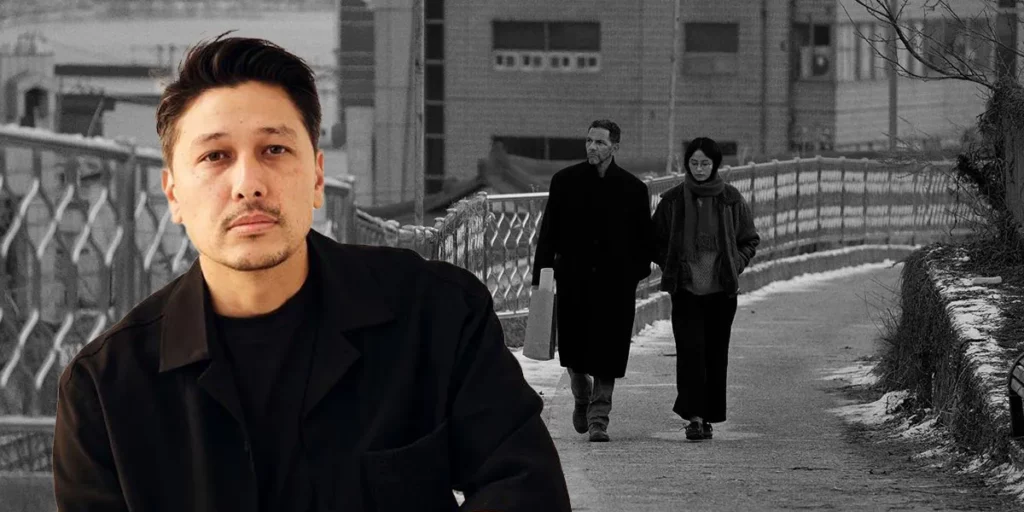We interview French-Japanese director Koya Kamura, whose debut feature film Winter in Sokcho premiered at TIFF 2024.
When his short film Homesick, about a father braving the Fukushima no-go zone to see his young son, garnered universal acclaim and an official selection at the 2021 César Awards, it was clear great things awaited Koya Kamura. In our interview, where we discussed the French-Japanese director’s craft, identity and approach to storytelling, that feeling was only heightened. Kamura has chosen to adapt Elisa Shua Dusapin’s wildly popular book “Winter in Sokcho” for his debut feature, which had its world premiere at the Toronto International Film Festival (TIFF) in September.
The novel tells the story of Soo-Ha (Bella Kim), a young woman whose quiet life in the sleepy South Korean town of Sokcho is upended by the arrival of a successful artist from France (Roschdy Zem), forcing her to confront her feelings around her own French heritage through her absent father. It is a tender, character-driven piece full of literary interiority, so translating it to the big screen was always going to be a challenge. Kamura’s adaptation is a smart one, clearly the work of an accomplished visual storyteller, his blend of animation and live action bringing the inner worlds of our two protagonists to life.
We sat down with Kamura for an interview about identity, language and the challenges of adapting Winter in Sokcho for the cinema.
Koya Kamura on choosing Winter in Sokcho as his first feature film project
How did you decide that you wanted Elisa Shua Dusapin’s book to be the source material for your first feature-length movie?
Koya Kamura: It was actually kind of by chance. At the time I was struggling on another project called Evaporated, which was supposed to be my first feature film. It takes place in Japan, and it talks about a Japanese phenomenon called ‘evaporation’, which is when someone suddenly leaves his family, job, everything, and just vanishes completely, goes to start a new life somewhere else.
At that time, I ran into Elisa Shua Dusapin’s book. As soon as I started to read it, I totally felt connected to the story and to the character. This story also talks about this girl that has never known her father because he left before she was born, so there was a kind of connection with what I was working on. Beside that, as I was reading, I really saw the pictures of the place in my head: this little town Sokcho in the north of South Korea. It’s described in the book as a place with a lot of empty spaces, as if everyone left, and my previous short film called Homesick was actually taking place in Fukushima, in the no-go zone, so I also felt very connected to the area.
I talked about it with my producer, who was really into the book as well, and this is how we decided to start working on it. After that, I got the chance to talk with the author, Elisa. There was a real connection; a lot of stuff in both of our lives felt very similar. That really encouraged me to make the decision to start working on this project. I didn’t know at the time if it was going to be my first feature or second one;. I was essentially hoping to make at least one film. So I just worked with the two projects at the same time, and this one went much, much faster than the other one.
So did you work closely with the author of the novel?
K.K.: Actually, no. I asked her if she wanted to be involved, and she said that she didn’t, because she had been involved in two adaptations for theater, and now she wanted to put some distance between her and the story. But we really got along and we’re still in contact now. Later on, she came onto set in South Korea, but she wanted it to be another story, another project; it was fine for me, because it allowed me to have my own vision.
What challenges did adapting Winter in Sokcho from book to film present?
K.K.: I guess every adaptation goes through the same kind of issues and challenges. For me, the main one was that this specific novel is really intimate. It’s written as if we were the main character, this girl, and as we look at the world through her eyes, we understand how she sees it; her vision of the world is what also really seduced me in the book.
I had to find a way to understand her interiority. I definitely didn’t want to use a voiceover, so I very quickly had this idea of using animation. Those animation sequences are, to me, kind of justified by the fact that the story has this French artist, and so I used these to try to show the audience some kind of glimpse at her interiority, her thoughts and feelings. It’s a bit more raw than what you have in the book, which is more elaborated and formulated with words. Here it’s more raw, more organic, more emotional. It’s like something she can’t control and this is just the way it appears in her heart.
Koya Kamura on the animated sequences in Winter in Sokcho
The animations are really beautiful, like moving expressionist paintings. How did you conceptualise these sequences? Were there different versions before you found the right look and feel for them?
Koya Kamura: I knew that I wanted animation, but the first idea that came to me was something very abstract. It was more like flashes, lines, dots, not really figurative. I also didn’t want to fall into the most obvious direction; we had this cartoonist coming in, but I didn’t want it to look like a cartoon or comic strip. I knew the work of an animation artist, a French girl called Agnès Patron, with whom I really wanted to work. I really liked her style – it was very pure, she used to draw on black paper and with white lines, which makes it darker and makes it more intimate and discrete.
So in the end, after I wrote the sequences, we worked together to find some different style. She did many tests and experiments to try different kinds of treatments and looks. I’m very glad I got a chance to work with her.
In terms of how you represent, as you say, the ‘interiority’ of the central character, it’s a very subtle film. For example, Soo-Ha’s eating disorder and her relationship with her body could easily be missed if you’re not paying attention. Are you drawn to this more implicit form of cinema, rather than explicit storytelling?
K.K.: When I read the book, the eating disorder was one of the themes that actually compelled me the most, for personal reasons. When I talked to Elisa about the book, this was actually one of the main things that I wanted to talk about. She was very surprised, because she had had different interviews before with other people that wanted to adapt the book, and no-one, especially among men, saw that or read that in the book, but for me it was very important.
I didn’t want it to be, as you said, too obvious; maybe some of the audience won’t see it. There is a very explicit scene where she’s actually throwing up, but until this moment where she explodes somehow, some people might find it a bit more discrete. But to be honest, I didn’t really think about how to show it. It just felt natural when I wrote the script: we wanted it to be kind of insidious – it’s there, but you don’t mention it clearly.

Language is another subtle aspect of the film. When Soo-Ha makes mistakes with her French it exposes a gulf between her and Zem’s character, as well as how distant she feels from her French ancestry. How important is language to our sense of identity?
K.K.: The reason why I really felt connected to the character, and to the author, is that the author is half French, half Korean, just like the character. I’m half-French, half-Japanese, and I feel that for my whole life I was kind of ashamed that I wasn’t able to speak Japanese. I learned Japanese, I speak it, barely, I’ve been working in Japan and shooting a film in Japanese, but still, I know that I haven’t mastered the language as I have French.
So this is a part of what defines me, I feel. Being half-French, half-Japanese, you’re never perfectly 50/50. But still, in the eyes of others… for Japanese people, I’m 100% French, and for the French, I’m 100% Japanese. So language is part of this pressure that I feel as well, not in French, but in Japanese. I felt I could imagine this character, Soo-Ha, this girl who never met her French father, but decided that she wanted to learn the language because she’s trying to fill this gap and meet the expectations people will have of her.
How Koya Kamura discovered the star of Winter in Sokcho
Bella Kim, in her first film role, is excellent as Soo-Ha. How did you discover her and what was it like to work with her?
Koya Kamura: That was very, very challenging, because the profile that I was looking for was very specific. I was looking for a 25-year-old-ish girl; I wanted her to be able to speak fluent Korean, and to have a very good level in French. I also wanted her to be quite tall, and ideally half-European and half-Korean.
I only met maybe four women that matched those criteria, and none of them had experience in filming before. But I could understand the very first time [Bella and I] met that she perfectly understood the character, the stakes of the film, and its themes. She worked so hard that she really filled that gap of experience. She was so invested in the film and on the shoot, and I’m very happy about the work she did.
What’s next for you?
K.K.: I’m going to try to enjoy the festival that we are in with this film. I’ve also finally finished the script of the other project I was struggling with, so we’re in the middle of looking for financing for that.
It takes place in Fukushima, again – I say again because I shot a short film there already. It’s the story of one of these ‘evaporated’ men that I mentioned earlier, who fled from his family and ended up among the workers cleaning up Fukushima after the nuclear disaster. They’re going to find a body over there, which will start an investigation, a kind of film noir set in the Fukushima area.
This interview was edited for length and clarity.
Winter in Sokcho was screened at TIFF on September 8, 2024.
Header credits: Koya Kamura (Gareth Cattermole/Getty Images for IMDb) / A still from Winter in Sokcho (Offshore & KEYSTONE FILMS / Courtesy of TIFF)

